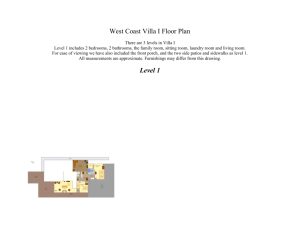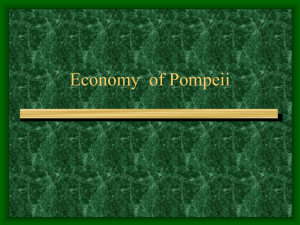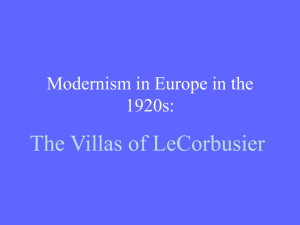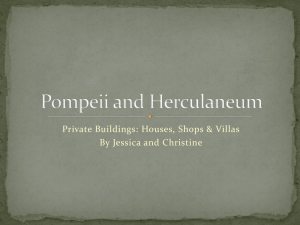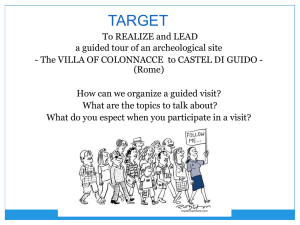1.5 notes - Personal.psu.edu
advertisement
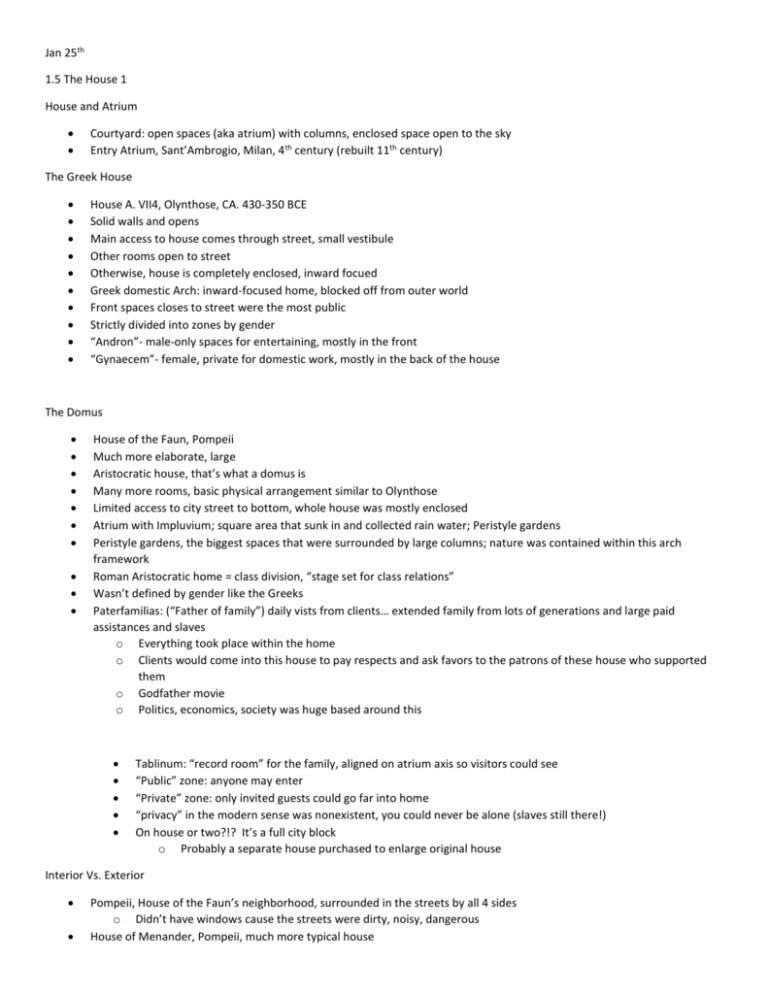
Jan 25th 1.5 The House 1 House and Atrium Courtyard: open spaces (aka atrium) with columns, enclosed space open to the sky Entry Atrium, Sant’Ambrogio, Milan, 4th century (rebuilt 11th century) The Greek House House A. VII4, Olynthose, CA. 430-350 BCE Solid walls and opens Main access to house comes through street, small vestibule Other rooms open to street Otherwise, house is completely enclosed, inward focued Greek domestic Arch: inward-focused home, blocked off from outer world Front spaces closes to street were the most public Strictly divided into zones by gender “Andron”- male-only spaces for entertaining, mostly in the front “Gynaecem”- female, private for domestic work, mostly in the back of the house The Domus House of the Faun, Pompeii Much more elaborate, large Aristocratic house, that’s what a domus is Many more rooms, basic physical arrangement similar to Olynthose Limited access to city street to bottom, whole house was mostly enclosed Atrium with Impluvium; square area that sunk in and collected rain water; Peristyle gardens Peristyle gardens, the biggest spaces that were surrounded by large columns; nature was contained within this arch framework Roman Aristocratic home = class division, “stage set for class relations” Wasn’t defined by gender like the Greeks Paterfamilias: (“Father of family”) daily vists from clients… extended family from lots of generations and large paid assistances and slaves o Everything took place within the home o Clients would come into this house to pay respects and ask favors to the patrons of these house who supported them o Godfather movie o Politics, economics, society was huge based around this Tablinum: “record room” for the family, aligned on atrium axis so visitors could see “Public” zone: anyone may enter “Private” zone: only invited guests could go far into home “privacy” in the modern sense was nonexistent, you could never be alone (slaves still there!) On house or two?!? It’s a full city block o Probably a separate house purchased to enlarge original house Interior Vs. Exterior Pompeii, House of the Faun’s neighborhood, surrounded in the streets by all 4 sides o Didn’t have windows cause the streets were dirty, noisy, dangerous House of Menander, Pompeii, much more typical house o Houses were essentially carved from solid blocks o You needed an atrium for light and air cause you couldn’t rely on street o Windows exterior were high, protected, small The atrium was like the core of the house, then rooms were attached to that To grow, a house would buy the neighbors To shrink, a house would sell rooms The exterior form of the house was irrelevant What made an house impressive was its interior; size, arrangement, design, overall sense of order, necessary arrangement of specific areas: atrium, tablio, peristilio, giardino Ancient Apartments Ancient Rome: hilltop enclaves for rich households Plebians: live in lower, overcrowded city districts Insulae: multistory, multifamily urban housing o Often collapsed and burned down Shops were on the ground floor, they had open courtyards at the center Upperfloor apt had windows and balconies The Villa Rome really was a crappy place, lots of people wanted to leave the city and go to the country Villa: traditional farmstead of Roman Aristocrat Evolvers into country retreat; pleasure, escape from city Villas were provided with elegant places, like dumos Villa Rustica (Rural Farm) and the Villa Suburbana (near the city) o Distinct domestic arch “type”, it’s actually a house! You can see exterior Breathing Room Anit-Domus: deliberately open to the outside o Windows, terraces, connections to nature Soak in nature before heading back to the city Still requires army of slaves, servants, and social stability Everyone except for rich people lived hard, gritty lives Roman army kept countryside “safe” for isolated houses in the rural area Villa lifestyle ended when Roman stability also ended.. therefore the medieval castle was created for defense Seaside Villa, Ancient Roman Wall Resco, CA. 60 CE Villa, House of M. Lucretius Fronto, Pompeii, CA. 40 CE The Medieval Domus Rise of cities again: aristocrats left the castles for urban life Alberti Tower and Loggia, Florence Medieval Florence: family power = neighborhood control Towers, Loggia, and Insignia were how these families marked the signs of family ownership Towers: provided safety when things go dangerous, which they often did Loggia: provided door space where public ceremonies were conducted Power Incognito Palazzo: elite family house, exterior visbility? Exteriors made it more impressive, show off the wealth of the family Shops were on the lower level, residential spaces above, courtyard above o Interior cortile: open, organizing vertical void, protected open air space, irregular geometry (rhombus)… sense of space counted the most Palazzo Giugni, late 14th century, Palazzo Rinuccini Changing the Rules Central Florence: carved up into family districts The Medici: newly wealthy family in banking, wanted to establish their status The city walls were being expanded The family bought property in the “suburbs”, the outside old city walls Sponsor major church projects at S. Marco and S. Lorenzo Build a brand new house at the most prominent corner of the city… this was their neighborhood Palazzo and Power Palazzo Medici: visible, 3D object that really stands out 80 feet high Inward focus, regular geometry, around an open courtyard, perfect squares, right angles Lots of stone work, elaborate wood work Unprecedented scale, expensive!!! 40,000 square feet! You didn’t need to step inside to see how impressive the place was, the exterior did that enough It was scandalous and arrogant, but it worked Declared prestige in a new way Social zoning: hortiztaonl layers, expressed in types of bricks used o Bottom floor, mostly shops o Middle, for family and guests o Third, personal family o Top was for servants “Model house” copycat palazzos, no one could copy them though A Room for One Palazzo: for family, servants, business, and religion Now privacy actually! The Studiolo- private room for male owner Space for the individual identity, and elite male privilege Inlaid wood imagery: shows Erudition, interests Express owners worldly knowledge and intellect, his uniqness Farm, Castle, Villa? Giusto Utens, view of Villa Medici at Cafaggiolo, remodeled 1450s Renaissance Florence: emulate ancient Roman culture Remote, rural family estantes were abandoned for city life Medici: remodeled house at Cafaggiolo into retreat “Villa” or castle? Machicolated towers (jut out to drop stuff on attactors), there were few windows o Safety was still Medici’s biggest issue The Villa Revived Florentine regional power = safer countryside Giusto Utens, view of the Villa Medici at Poggio A Caiano, 1485-1520 Poggio A Caianon: symmetry, views, interior-exterior Encourage vistors to take in views and fresh air “Nature”: agriculture, formally designed gardens Area around the house has an enormous front yard, plain Ag gardens in the back, then very geometrical gardens around too, perfected piece of nature Villa: framework for experiencing the landscape Villa as Contrast One villa type: compact from as “perfect” foil for nature Villa Rotunda: hilltop location, dominates the surroundings Spaces for viewing the landscape are integrated into the main form of the home 4 porches, perfectly semetrical Relationship between nature and home… you can see the nature, or you can see the nature and see the house Strictly a pleasure house Palladio, Villa Torunda, Vincenza, 1567-70 The Integrated Villa Other option: open design, extending into landscape Houses long, U shaped plan, maximizes perimeter Has loggias, garden connect to nature A little bit of “perfected nature” Villa Maser: both working farm and a country home for pleasure Palladio, Villa Barbaro, Maser, 1560-70 Town and Country Palladio’s books (he was also an author): spread taste for villas to Great Britain Londesborough Hall, Ca. 1709 Burlington House, London c. 1698, had this remodeled Richard Boyle, fan of Palladio: aristocrat, 3rd Edarl of Burlington… he was a seasonal “commuter”, lifestyle defined between town and country Yorkshire Estate: engine of wealth, theater of local power London Townhouse: rituals of national class affiliation Inherited family patrimony; he was expected to maintain these houses then pass on to the heirs o Were only about the family, not about himself, the inidivdual o He was obsessed with arch and wanted to express himself in built form An English Villa He built himself a new house This third house, the villa, was a middle ground between the estate and the townhouse Chiswick House: “small” Palladian house by Burlington Constructs individuality vs. family or class affiliation This was his private realm, would only invite like 1 or 2 people Similar to Palladio Rotunda House of the Muses Housed his library, art collection, architectural studio Lord Burlington, Chiswick House, 1726-29 Entire house designed to express character and identity of one specific person: not social class or family, but who HE is to himself and the world Attached Housing John Wood the Younger, Royal Crescent, Bath, beg. 1767 Bath: Genteel Resort city: urban life for prosperous Uses long ribbon of attached houses to define a neighborhood Wraps homes around a circle, then down Royal Crescent: unified form for luxury row houses Design: harmonious street façade is what you see, when they really are individual units Elite class identity, uniformity, and social control… group membership! Uniformity from the street showed the social purpose of how elite they were… this was a neighborhood where the elite class had control City Life and Democracy Row houses: combine density with private housing Brick Row Houses, Philly, Brooklyn Brownstones U.S. cities: balance overall order and individuality Form was so important; doors, projecting stairs, sometimes physical breaks between houses Social identity through arch was just as important Class pressure: “democracitic” uniformity vs. display So wealth shouldn’t be done, it was like the rigid social system that was rejected, so you wanted to be modest like everyone else or they would hate you New World Aristocrats Main House, Evergreen Plantation, Wallace, LA 1832 vs slave cabins American South: deliberate imitation of British Elite Domestic Arch: reflects rural estates, villas Symmetry, dramatic entry stairs, all project dignity and importance Wealth and elite status Plantation: wealth through large-scale agriculture Built on the labor of slaves (blacks) Emphasis on radical difference expressed in housing Some slaves had access to main house, most lived separately You could tell the difference clearly between the slaves and owners… socially, etc. Where you lived reflected who you were Plantation owners were new world aristocrats Presidential Villa Thomas Jefferson, Monticello, Charlottesville, VA, 1768-1809 Thomas Jefferson: American politician, amateur Architect Wanted to express himself through his home like the other guy Has lots of features similar to Villa Rotunda… domes, sits on hill Monticello: compact Palladian villa, more “private” scale Looks like a smaller home but… in realitiy, it was a plantation Was home to more than 100 people! (80+ slaves) Mascarade makes the house not look too big, but its 4 stories Together and Alone The site hides how big the house really is Monticello combines villa types: contrast and extension Dependencies: separate wings on a lower level Zones the community socially and racially, does so through design Contain and express support functions for elegant life Coordinated, collective living supports a private life Did a huge amount of entertaining But he also did this to quentch his thirst for private: Jefferson’s “cabinet”… he made devises that would elimate help from slaves… This was both a community and a space that he wanted for himself Both a house of many and house that is ultimately meant for the comfort and pleasure of one American Mythology Log house, East Berline, PA, 1832 House takes on increasingly important role in America Farming, houses, and the ‘real America”… do “good houses” produce “good people?”


